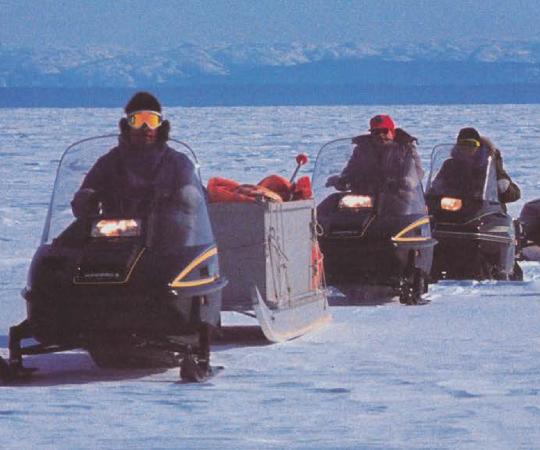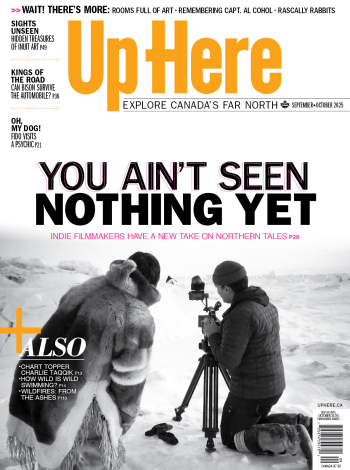The teen dance in Arviat is a popular affair. Throngs of teens, pre-teens and slightly post-teens fill the wood panelled community hall and mill around the canteen. Some dance. A laptop on stage shuffles through a playlist of new pop. Outside, more kids roll up on ATVs (called “Hondas” regardless of the actual make), spitting tobacco and sharing exchanges of “huvi?”—regional slang for "what’s up?"
Arviat has a reputation for being young, safe and friendly. It is home to Nunavut’s fastest growing population—2,900 or so at the hamlet's last count—and over half are under the age of 20. Violent crime is low, and Inuit culture and language is strong; 95 per cent speak Inuktitut. Kids show a genuine interest in visitors, stopping to ask questions, kick a soccer ball or just say huvi. (You can reply nau, as in “not much.”)

Since the highest landmark as far as the eye can see is a 50-foot radio tower and the place is so quaint, it seems deceiving but the hamlet of Arviat, by Nunavut standards, is a city. It hums with the put-put of Hondas and snowmobile traffic, and has three taxi co.’s—Lola’s, Jimmy’s and Ibit-U-Drive. And it has not one but two stores open until 1 a.m. offering soft-serve ice cream, which is more than most parts of downtown Ottawa can say. Its community eco-tourism program has been picking up steam, winning an international tourism award last year. But for all it has going for it, the place refuses to thrive economically.
“Some people say this community is jobless,” says Ethan Tassiuk. He and high school student Elena Akammak are members of the Leadership Resiliency Program. They say Arviat needs a new restaurant and new hotel. “After we graduate we’re planning to start a business here,” says Akammak.
Andy Evaloakjuk agrees a hangout place beyond weekend teen dances and convenience stores would go a long way, both to add jobs to the community and to give youth a place to spend time and stay out of trouble. He says many kids languish without jobs or direction, evidenced in how they resort to smoking cigarettes or chewing snuff. “We need more activities and more education to make them stop doing that stuff.”
Population-wise, Arviat is neck-and-neck with Rankin Inlet as Nunavut’s second-largest community after Iqaluit. But unlike Rankin, Arviat is not a regional hub of headquarters for organizations, government or industry in the Kivalliq.
“That spins off into more jobs in the hospitality industry, more jobs in the retail industry, more jobs in construction and trades and all that stuff. We definitely don’t see that kind of economic activity here,” says community economic development officer Keith Collier.
In all, there are four retailers in town, each with a stack of résumés “this high,” says the hamlet’s Michelle Malla, hovering a hand several inches above her desktop. “There are graduates who graduated a long time ago who are unemployed.”
One way of drumming up tourism traffic and creating more jobs is Arviat’s famous community eco-tourism program—ACE for short. Not only does it draw in visitors, the program also hires local people—many who are without wage-paying jobs—to showcase authentic culture and wildlife of the region. In other words, elders and youth take visitors out on the land, which is abundant with wildlife (located in Nunavut’s so-called “Polar Bear Alley”) and history (two National Historic Sites nearby), and most ACE tours come with meals and the chance to try local country food like caribou. Best of all, the ACE program is hamlet-owned so all money stays in the community.

Malla, 23, is the hamlet’s go-between for work with Agnico Eagle. The mining giant is the biggest economic driver with two-week-in, two-week-out work at the Meadowbank mine near Baker Lake. She says it comes down most of all to education. The more educated an applicant is, the more likely they are to get hired. For 15 spots in a work readiness program, she received 80 applications. “It gets very tense here. We want to take everybody.”
In fact, everyone I spoke with in one way or another agrees what the community needs more of are jobs and resources for the younger generation, which makes up such a large part of the community. The hamlet hopes all that will follow with major investments over the next few years. A fourth school is in the works, and the housing authority continues to build roughly the same number of new housing units as Iqaluit each year.
Collier says the hamlet is also in the process of revamping an area behind the airport into an eco-park, with a walking path, observation points and performance area. He says this summer the hamlet will astro-turf the baseball diamond and tack on basketball and volleyball courts, a soccer field and mini-putt course. “Basically a ton of outdoor recreational facilities for all these kids, because they certainly need it.”









